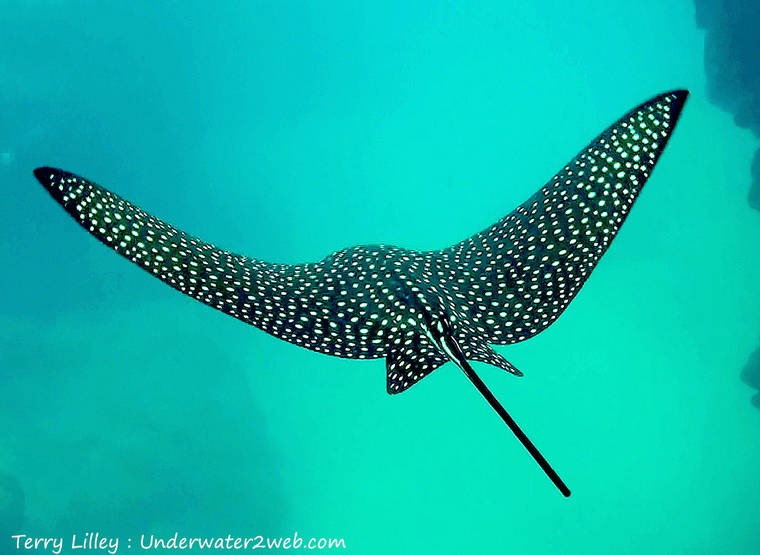Meet hihimanu the spotted eagle ray. Its Hawaiian name means “magnificent,” and if you have ever seen one fly by you underwater like a giant butterfly, you will know how it got its name!
In the Hawaiian naming of marine life there is often something on land with the same name that shares a connection with one of the sea creatures. When you drive to the North Shore of Kauai and down into the town of Hanalei, look up at the tall mountains to your left. You will see a set of two peaks that look like the wing tips of a ray. It is truly magnificent to look at and the mountain is also called hihimanu.
The eagle ray has a very special place in old Hawaiian culture as it was said to be the guardian of the coral reef! Many times when I am out diving and studying a diseased or sick part of the reef the eagle ray shows up and spends time with me there as if wanting to help figure out why the reef is sick and deciding what we can do about it.
I have spent many hours out underwater by myself in Hanalei Bay with hihimanu and have lots of wonderful movies of these special creatures as they gracefully glide over the coral reef.
Hihimanu has large wing like pectoral fins that connect all the way from the tail to its head and its wingspan can be up to six foot. It also has a very long tail and has several venomous spines at the base of the tail. The underside of the ray is pure white so if you are below it the ray may blend in with the sky above.
The top of the ray is black with white spots so if you look down on the eagle ray is blends in with the bubbles in the surf and reef below. Like most all sting rays, they do not harm people and only use their poisonous barbs if being attached by a big shark or other predator.
Hihimanu is often seen gliding just below the surface by itself or sometimes in schools of three or more. They have a large head with a huge mouth on the underside so it can feed on clams, crabs and other small creatures that live under the sand on the sea floor.
Under the broad head are electromagnetic sensors that can detect the biological energy of a hidden crab six inches below the ocean floor! Most sharks and rays have this capability which allows them to find they prey without seeing or smelling it. Hihimanu has powerful flat jaws that can crush a large clam to eat the soft insides and spit out the broken shell.
Divers often find big six-foot-wide holes dug in the sand that look like a sand volcano had erupted. These are the holes dug with the rays mouth and powerful fins when they detect a food item below the sea floor surface. It is really fun to watch them foraging for food as you can see the cloud of sediment kicked up by their digging from 50 feet away if the water is clear!
Eagle rays usually mate and reproduce in calm bays where they sometimes jump totally out of the water in some sort of mating dance. They have even been known to jump right into a boat! The female keeps her eggs inside of her body until they hatch, then gives birth to four to six live pups.
You can watch hihimanu in action in my movie, “The World’s Guide To Hawaiian Reef Creatures,” up on my underwater educational web page at www.underwater2wew.com. You can also follow my marine life educational Instagram post at terry.lilley
Aloha from under the surf.
•••
Terry Lilley, marine biologist, Hanalei, underwater2web.com, www.gofundme.com/5urrm4zw, All Photographs © 2016 Terry Lilly




